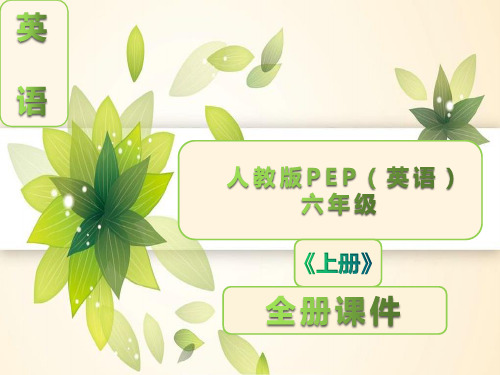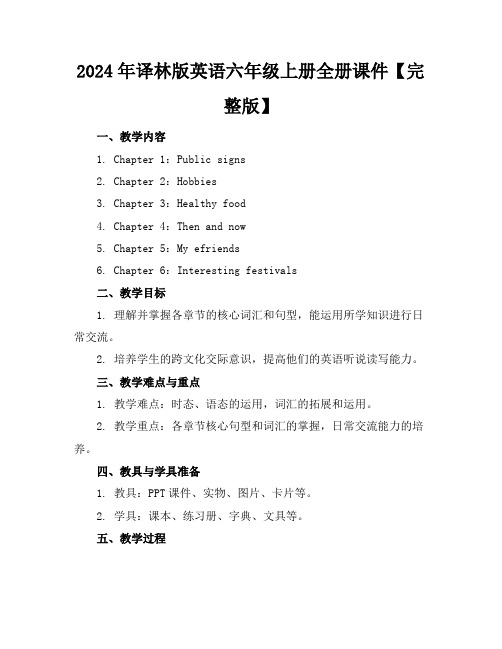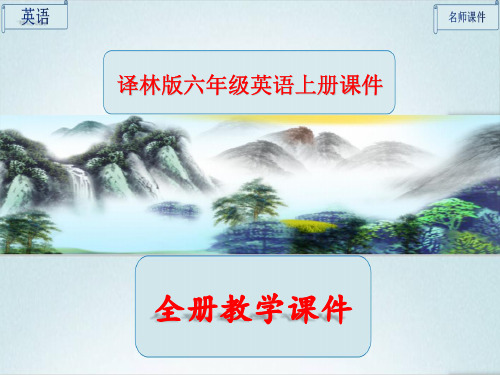译林版六年级英语上册全册全套课件【完整版】
译林版英语六年级上册全册课件全套

Let’s talk
--Where is the post office?
near 在……附近
next to在……附近,靠近… --It’s behind在……后面
in front of在……前面
火车=train
by train 乘坐火车
(大)船 = ship by ship 乘船
飞机 = plane
by plane 乘坐飞机
— How do you come to school? — I usually/ often/ sometimes...
usually: 通常 often:经常 sometimes:有时候
— How do you get to Beijing? —By train. — How do you get to the USA from China? —By plane.
游景区。北海公园兼有北方园林的宏阔气势
和江南私家园林婉约多姿的风韵。
天安门
Let’s check (page 10) 文本: Today, I want to go to the museum. From my school I go straight and turn left at the post office. I can see the bookstore there. From there I go straight ahead. Then, at the cinema I turn right. Finally, I’m at the museum. It’s not far.
Man: No. Go straight and turn left.(不远,直走再向左转就可以了。)
2024年译林版英语六年级上册全册课件【完整版】

2024年译林版英语六年级上册全册课件【完整版】一、教学内容本课件基于2024年译林版英语六年级上册全册教材,详细内容包括:1. Unit 1: Public signs (第14课时)知识点:公共场所标识的认识,祈使句的运用章节内容:第1章公共标识,第2章祈使句2. Unit 2: Western festivals (第58课时)知识点:西方节日文化,一般将来时的运用章节内容:第3章西方节日,第4章一般将来时3. Unit 3: Habitats (第912课时)知识点:动植物的栖息地,现在进行时章节内容:第5章栖息地,第6章现在进行时4. Unit 4: Keep fit (第1316课时)知识点:健康生活,一般现在时的运用章节内容:第7章健康生活,第8章一般现在时二、教学目标1. 让学生掌握基本的公共标识,学会使用祈使句进行表达。
2. 了解西方节日文化,学会运用一般将来时描述节日活动。
3. 认识动植物的栖息地,掌握现在进行时的用法。
4. 培养学生的健康意识,学会用一般现在时描述生活习惯。
三、教学难点与重点1. 教学难点:祈使句、一般将来时、现在进行时、一般现在时的运用。
2. 教学重点:公共标识、西方节日文化、动植物的栖息地、健康生活。
四、教具与学具准备1. 教具:PPT课件、卡片、挂图等。
2. 学具:教材、练习册、彩笔、剪刀、胶水等。
五、教学过程1. 实践情景引入:通过展示公共场所的标识,引导学生学习祈使句。
2. 例题讲解:讲解祈使句的构成及用法,举例说明。
3. 随堂练习:让学生练习编写祈使句,并在实际场景中运用。
4. 情景剧:分组进行角色扮演,模拟公共场合使用祈使句。
5. 节日文化介绍:通过PPT展示,介绍西方节日,学习一般将来时。
6. 例题讲解:讲解一般将来时的构成及用法,举例说明。
7. 随堂练习:让学生练习描述节日活动,运用一般将来时。
8. 栖息地学习:展示动植物的栖息地图片,引导学生学习现在进行时。
译林版英语六年级上册全册课件【完整版】

译林版英语六年级上册全册课件【完整版】一、教学内容1. Unit 1 The King's New Clothes(国王的新装)故事阅读:The King's New Clothes词汇:clothes, beautiful, magic, honest, fool, point, cry, walk语法:一般现在时,一般过去时故事阅读:What a Day!词汇:sunny, cloudy, windy, rainy, snow, weather, hot, cold语法:现在进行时3. Unit 3 Holiday fun(假期乐趣)故事阅读:Holiday fun词汇:holiday, farm, cow, horse, chicken, cook, read, make语法:一般过去时4. Unit 4 Then and now(那时和现在)故事阅读:Then and now语法:一般过去时,一般现在时二、教学目标1. 掌握各单元词汇、短语和句型,提高学生的英语表达能力。
2. 熟练运用各单元语法知识,进行简单句子和段落的编写。
3. 培养学生的阅读兴趣,提高阅读理解能力。
三、教学难点与重点1. 教学难点:一般过去时和现在进行时的运用,词汇的扩展和运用。
2. 教学重点:故事阅读理解,词汇和语法的学习。
四、教具与学具准备1. 教具:课件、黑板、磁铁、卡片2. 学具:课本、练习本、彩笔五、教学过程1. 导入:通过图片、歌曲等方式引入新课,激发学生的学习兴趣。
2. 新课内容展示:呈现新课故事,引导学生进行阅读理解,学习词汇和语法。
3. 例题讲解:针对重点和难点,进行例题讲解,帮助学生掌握知识。
4. 随堂练习:设计相关练习,巩固所学知识。
5. 小组活动:分组讨论,进行角色扮演,提高学生的口语表达能力。
六、板书设计1. Unit 142. 词汇:各单元重点词汇3. 语法:一般现在时、一般过去时、现在进行时4. 句型:各单元重点句型七、作业设计1. 作业题目:Write a short story about your holiday fun.Describe the changes in your life using "Then and now".Draw a picture and describe the weather.2. 答案:见附件八、课后反思及拓展延伸1. 反思:针对课堂教学效果,及时调整教学方法,以提高教学效果。
2024年译林版英语六年级上册全册课件【完整版】

2024年译林版英语六年级上册全册课件【完整版】一、教学内容1. Chapter 1:Public signs2. Chapter 2:Hobbies3. Chapter 3:Healthy food4. Chapter 4:Then and now5. Chapter 5:My efriends6. Chapter 6:Interesting festivals二、教学目标1. 理解并掌握各章节的核心词汇和句型,能运用所学知识进行日常交流。
2. 培养学生的跨文化交际意识,提高他们的英语听说读写能力。
三、教学难点与重点1. 教学难点:时态、语态的运用,词汇的拓展和运用。
2. 教学重点:各章节核心句型和词汇的掌握,日常交流能力的培养。
四、教具与学具准备1. 教具:PPT课件、实物、图片、卡片等。
2. 学具:课本、练习册、字典、文具等。
五、教学过程1. 导入:通过呈现与各章节相关的实践情景,引导学生进行讨论,激发学习兴趣。
2. 新课内容展示:详细讲解各章节的核心词汇和句型,结合例题进行讲解。
3. 例题讲解:针对重难点,设计典型例题,进行详细讲解和分析。
4. 随堂练习:设计有针对性的练习题,巩固所学知识。
六、板书设计板书设计简洁明了,突出各章节核心词汇和句型,如下:Chapter 1:Public signsCore words: sign, danger, prohibition, instruction, warningKey sentences: There is a sign that saysChapter 2:HobbiesCore words: hob, painting, drawing, collecting, readingKey sentences: My hob isChapter 3:Healthy foodCore words: healthy, fruit, vegetable, balanced, dietKey sentences: I like to eatChapter 4:Then and nowCore words: then, now, change, different, sameKey sentences: Then, I used toChapter 5:My efriendsCore words: friend, efriend, message, chat, onlineKey sentences: I have an efriend whoChapter 6:Interesting festivalsCore words: festival, celebration, custom, tradition, activityKey sentences: We celebrate七、作业设计1. 作业题目:(1)根据各章节核心词汇和句型,编写一段对话。
译林版英语六年级上册全册课件【完整版】

译林版英语六年级上册全册课件【完整版】一、教学内容1. Unit 1 The King's New Clothes (故事、词汇、语法、文化)2. Unit 2 What a Day! (故事、词汇、语法、写作)3. Unit 3 Holiday Fun (故事、词汇、语法、听力)4. Unit 4 Then and Now (故事、词汇、语法、阅读)5. Unit 5 Signs (故事、词汇、语法、口语)6. Unit 6 Keep Fit (故事、词汇、语法、健康)7. Unit 7 Protect the Earth (故事、词汇、语法、环保)8. Unit 8 Christmas (故事、词汇、语法、节日)二、教学目标1. 掌握各单元的核心词汇和句型,提高英语表达能力。
2. 通过听力、阅读、写作等训练,提升综合语言运用能力。
3. 了解各单元话题相关的文化、历史、社会知识,拓宽视野。
三、教学难点与重点1. 教学难点:时态、语态的正确运用;词汇的扩展和运用。
2. 教学重点:各单元话题的核心词汇和句型;听、说、读、写四项技能的综合运用。
四、教具与学具准备1. 教具:PPT课件、黑板、录音机、卡片等。
2. 学具:课本、练习册、字典、笔记本等。
五、教学过程1. 导入:通过情景引入,激发学生兴趣,为新课内容做好铺垫。
2. 新课内容呈现:采用故事、对话、图片等形式,展示新课内容。
3. 例题讲解:针对重点、难点进行详细讲解,帮助学生理解和掌握。
4. 随堂练习:设计针对性练习,巩固所学知识。
5. 小组活动:分组讨论、表演,提高学生的合作能力和口语表达能力。
六、板书设计1. 核心词汇和句型。
2. 重点语法点。
3. 各单元话题。
七、作业设计1. 作业题目:Write a short story about your holiday.Make a poster about protecting the Earth.Write a letter to Santa Claus.2. 答案:见附录。
译林版英语小学六年级上册全套ppt课件

课堂练习 教学目
标
将下列动词过去式归类
live
like am -ed
shout
is show
laugh
look hope -dwlkpoint are 不规则变化
说出下列动词的过去式,看 谁说的又对又快
laugh carry hope walk study like point look are is live am looked walked laughed pointed studied were carried liked hoped was lived was
Free talk
Do you like new clothes?
导入新课 教学目
标
课文展示 教学目
标
What do you think of the king?
单词讲解 教学目
标
long long ago 很久以前
long long ago before
now
future
Long long ago,there was a king.
The men showed the king his new clothes,but the king could see not____them.
The king walked through the city in his new clothes.A________pointed little boy and laughed.
hard 努力地,费劲的 He works hard.
Game
游戏规则 (1)说出图片中汉语的对应的单词。 : (2)在图片之下藏有单词,请问哪
一个被藏单词与图片所含的单词相同 ?
译林版英语六年级上册全册优质课件【完整版】

译林版英语六年级上册全册优质课件【完整版】一、教学内容二、教学目标1. 让学生掌握全册核心词汇和重点句型。
2. 培养学生运用英语进行日常交流能力。
3. 提高学生阅读理解能力和写作水平。
4. 增强学生环保意识,培养他们责任感。
三、教学难点与重点1. 教学难点:时态运用、词汇扩展、阅读理解提高。
2. 教学重点:词汇、语法、阅读和写作实践运用。
四、教具与学具准备1. 教具:PPT课件、录音机、磁带、卡片。
2. 学具:课本、练习册、笔记本、文具。
五、教学过程1. 导入:通过呈现与单元主题相关图片或视频,激发学生兴趣,引导他们进入学习状态。
2. 新课内容展示:详细讲解每个单元词汇、语法、阅读和写作内容,结合实践情景,让学生在互动中学习。
3. 例题讲解:针对每个单元重点知识点,设计典型例题进行讲解,帮助学生巩固所学。
4. 随堂练习:针对每个知识点,设计相应练习题,让学生在课堂上及时巩固。
5. 互动环节:组织学生进行小组讨论、角色扮演等互动活动,提高他们实践运用能力。
六、板书设计1. 每个单元核心词汇和句型。
2. 语法点详细讲解。
七、作业设计1. 作业题目:每个单元单词拼写和翻译。
根据单元主题,编写一篇小作文。
完成课后练习题。
答案:单词拼写和翻译:见课本附录。
小作文:根据所学内容进行创作,注意语法和词汇运用。
课后练习题:参照课本答案进行核对。
八、课后反思及拓展延伸2. 拓展延伸:鼓励学生在课后进行阅读、观看英语动画片等,拓宽知识面,提高英语水平。
同时,组织英语角等活动,为学生提供更多实践机会。
重点和难点解析在教学过程中,有几个细节是我需要特别关注。
是教学内容把握,是教学难点和重点针对性教学,然后是作业设计,以及课后反思和拓展延伸。
一、教学内容把握我在教学内容选择上,要确保每个单元核心词汇、语法点和阅读写作技巧都得到充分讲解和实践。
特别是Unit 1至Unit 7每个章节,我需要细化每个环节,确保学生能够循序渐进地掌握知识。
译林版英语六年级上册全册课件【完整版】

过教去学式目
原形
laugh point shout show look
过去式
laughed pointed shouted showed looked
规律:动词原形变为过去式时,一 般直接在动词后加ed.
原形
过去式
like
liked
live
lived
am
was
is
was
are
were
规律:以不发音e结尾的动词,变为过
He is clever
But he is very foolish. foolish 愚蠢的
Do you like them? They are cute. But it is very strong,it can cross through the fire.
through 穿过
wear 穿 laugh 大笑
Who is he? He is Harry Potter.
He is a Magician(魔法师). magic 有魔力的,神奇的
Do you know him? He is Einstein(爱因斯坦). He is very clever.
clever 聪明的
He is clever, too.
Two men wanted to make new clothes for the king.The king was__h_ap_p_y___.
The men showed the king his new clothes,but the king could not_s_e_e_them.
The king walked through the city in his new clothes.A_l_it_tl_e_b_o_y_pointed and laughed.
译林出版社1(牛津英语)小学六年级英语上册全套PPT课件

Where can we see them?
我们可以在公园的什么地方看到它们?
Where is this sign?
There’s a sign on the wall.
Where is this sign?
There’s a sign on the grass.
Where is this sign?
看图,分别说说以下标志的含义
What does it mean?
What does it mean? It means “Danger”.
What should we do? (我们应该怎么做?) We must stay away from the building. (远离) (我们必须远离这座建筑。)
Where are you now? What signs do we need in this classroom?
模仿课文内容,利用教室里的标志,进行对话练习
A: There are a lot of signs here…
Try to say
B: Yes. They’re public signs. They mean different things. A: There’s a sign on the …. What does it mean?
读书上前言,回答问题
Q3: What is Jack doing now? He is asking Ben some questions.
ask 问
Try to read 读一读
Today is Saturday. Ben and his
Cousin, Jack, are in the park. Jack is
Learn the new words
- 1、下载文档前请自行甄别文档内容的完整性,平台不提供额外的编辑、内容补充、找答案等附加服务。
- 2、"仅部分预览"的文档,不可在线预览部分如存在完整性等问题,可反馈申请退款(可完整预览的文档不适用该条件!)。
- 3、如文档侵犯您的权益,请联系客服反馈,我们会尽快为您处理(人工客服工作时间:9:00-18:30)。
钟。
Zoom: Excuse me. Where is the London
Eye? (打扰一下,请问伦敦眼在哪里?) Man: It‘s next to the film museum near
Wu yifan and his friends want to eat some pizza in an Italian r_e__gso_t_as_tur_ar_iga_h_nt_t_._T__h_e_y______._T__h_e_y______and __t_u_rn__le_f_t _a_t _thaenbdooktshtoeren turn right agtuarninri.ght
火车=train
by train 乘坐火车
(大)船 = ship by ship 乘船
飞机 = plane
by plane 乘坐飞机
— How do you come to school? — I usually/ often/ sometimes...
usually: 通常 often:经常 sometimes:有时候
train
subway
car bike
bus taxi
o you go to school?
on foot
步行
自行车 = bike
by bike
骑自行车
乘... = by...
by bus 乘公共汽车
by taxi
乘坐出租车
地铁:subway
by subway 乘坐地铁
伦敦眼
伦敦眼(The London Eye),或又 称为千禧之轮(Millennium Wheel)
是世界上首座、也曾经是世界最大的观 景摩天轮,仅次于南昌之星与新加坡观 景轮。它于1999年年底开幕,总高度 135米 ,竖立于伦敦泰晤士河南畔的兰
贝斯区,面向坐拥国会大楼与大笨钟的 西敏市。伦敦眼共有32个乘坐舱,因舱
the Thames.(在靠近泰晤士河的电影院旁边)
泰晤士河 The Thames,在英格兰牛津又称伊希 斯河(River Isis)。英国第二大的河流,也是最 重要的水路,又是英国的母亲河。
Zoom: Excuse me. Is The Thames far from here?(打扰一下,泰晤士河距离 这里远吗?)
北海公园(Beihai Park),位于北京市中
心区,城内景山西侧,在故宫的西北面,与 中海、南海合称三海,属于中国古代皇家园 林。北海是中国历史园林的艺术杰作。全园 以北海为中心,水面占583市亩,面积约71 公顷,陆地占480市亩。这里原是辽、金、
元建离宫,明、清辟为帝王御苑,是中国现 存最完整、最古老、最具综合性和代表性的 皇家园林之一,1925年开放为公园,为中国 全国重点文物保护单位,是国家AAAA级旅
between…and…
在……和……之间 on…street在……街道上
Q: Where is the park? Q:The Zoo is _______ the post office. Q: The school is ______ the library.
Let’s try (page 6) 3’13”
游景区。北海公园兼有北方园林的宏阔气势
和江南私家园林婉约多姿的风韵。
天安门
Let’s check (page 10) 文本: Today, I want to go to the museum. From my school I go straight and turn left at the post office. I can see the bookstore there. From there I go straight ahead. Then, at the cinema I turn right. Finally, I’m at the museum. It’s not far.
Story time (page 11)
Zoom: Hey, that looks tasty. Where can I buy one?(嘿,那个 看起来很好吃,我可以在哪里买 到?)
Boy: Near the London Eye. Go that way.(在伦敦眼附近,走那条 路可以去。)
--Where is the post office? --It’s near the hospital.
Let’s talk
--Where is the post office?
near 在……附近
next to在……附近,靠近… --It’s behind在……后面
in front of在……前面
比萨斜塔 Italian 意大利的
餐厅 restaurant
披萨 pizza
街道 street
Let’s talk (page 6)
hospital bookstore
restaurant
cinema
十字路口 Crossing
向左转 turn left
直走 go straight
向右转 turn right
— How do you get to Beijing? —By train. — How do you get to the USA from China? —By plane.
I usually come to school on foot. I often come to school by bus. I sometimes come to school by bike.
— How do you get to school? — I go to school on foot.
Man: No. Go straight and turn left.(不远,直走再向左转就可以了。)
Zoom: look.
Zip: Finally.
Homework
Unit 2
Ways to go to school
How many transportations do you know?
plane ship
